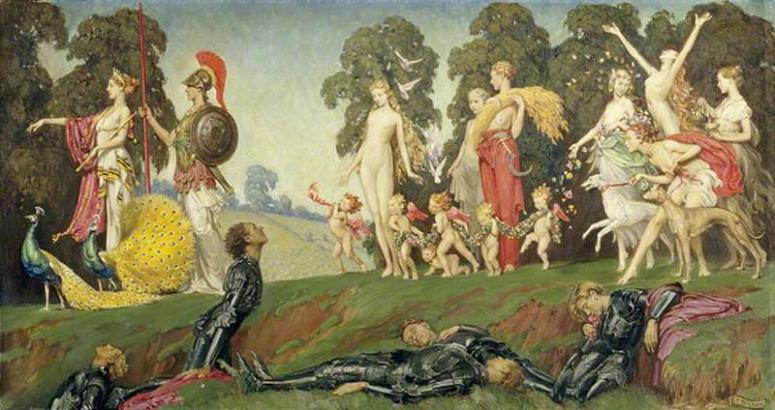Clevedon Court. Clevedon Court is a manor house on Court Hill in Clevedon, North Somerset, England, dating from the early 14th century. It is now owned by the National Trust. It is designated as a Grade I listed building. The house was built and added to over many years. The great hall and chapel block are the earliest surviving parts of the structure with the west wing being added around 1570, when the windows and decoration of the rest of the building were changed. Further construction and adaptation was undertaken in the 18th century when it was owned by the Elton baronets. The house was acquired by the nation and was given to the National Trust in part-payment for death duties in 1960. The Elton family is still resident in the house, which is now open to the public. In addition to the main house, the grounds include a selection of walls and outbuildings, some of which date back to the 13th century. The gardens are listed on the National Register of Historic Parks and Gardens. Much of the present house was built in the early 14th century by Sir John de Clevedon. There is speculation that it may lie on the site of a Roman building, based on excavations to the south of the house in 1961/62. The house incorporates remnants of a 13th-century building which lie at an angle to the rest of the house. It was situated nearly two miles inland from the parish church of St Andrew, which stands on the coast. After the Norman Conquest of 1066, the manor of Clevedon was granted by the King to Matthew de Mortagne, who in turn granted it to his sub-tenant, Hildebert. It is thought that Sir John was a descendant of either Matthew or Hildebert. Perhaps because of the distance to the parish church, the manor house included a chapel dedicated, in the 1320s, to Saint Peter. The house has undergone considerable change since it was built, almost every century seeing structural alterations, but it still retains many features of a mediaeval manor house. The de Clevedon family line ended in 1376, and the manor eventually passed, by marriage, to the Northamptonshire family of Wake, who were Lords of the Manor until 1630. John Wake made major additions to the house in the late 16th century, including a new west wing. The manor was sold by Sir John Wake to Sir John Digby in 1630. Digby's estates were confiscated during the English Civil War, but were recovered after the Restoration by his heir. In 1709 the house was bought by Abraham Elton, a merchant from Bristol. The Eltons were a prominent Bristol family, and Abraham 1st was Sheriff of Bristol in 1702, a member of the Society of Merchant Venturers becoming Master in 1708, Mayor of Bristol in 1710, and High Sheriff of Gloucestershire in 1716. He became a member of parliament for the five years preceding his death in 1728. He was created a baronet in 1717 as the first of the Elton baronets. The family wealth originally came from copper and brass and other commerce, and property. His descendants, not only at Clevedon, also profited from the slave trade. Sir Abraham Elton was succeeded by four further Sir Abraham Eltons. Sir Abraham Elton, 2nd Baronet, and his son Sir Abraham Elton, 3rd Baronet, were also Sheriff and Mayor of Bristol in their time, and the second Baronet was also MP for Taunton 1722-1727, succeeding to his father's seat of Bristol in 1727 until his own death in 1742, despite being nearly ruined in the South Seas Bubble crisis. The third Baronet died bankrupt, and the estate passed in 1761 to his brother, Sir Abraham Isaac Elton, 4th Baronet. He made substantial changes to the house and grounds in the then fashionable Gothic revival style, and was succeeded in 1790 by his son, Sir Abraham Elton, 5th Baronet. He was ordained as a young man, and was a curate in West Bromwich before inheriting the title. He was a supporter of Hannah More, and a fervent opponent of Methodism, at one time inducing the vicar of Blagdon to sack his curate, causing a national scandal. His second wife, Mary, made further alterations to the house in the early 19th century, and also made many improvements to the town, including a school. One of the town's modern primary schools is named after her. The line of Abrahams came to an end in 1842 when Sir Charles Abraham Elton, 6th Baronet, succeeded his father. Sir Charles was a writer, and contributed to several periodicals including The Gentleman's Magazine. Sir Charles' sister Julia was married to the historian Henry Hallam, and his nephew Arthur Hallam is buried in the Elton family vault at St Andrew's church. Arthur Hallam is the subject of Alfred Tennyson's poem In Memoriam A.H.H. Tennyson visited Clevedon Court in 1850, the year in which the poem was published, and also in which he was created Poet Laureate.
more...



